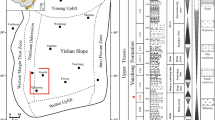Abstract
An experimental method of field-emission environmental scanning electron microscope (ESEM) coupled with the energy dispersive spectrum (EDS) to determine the thickness of oil films in the micro- and nano-pores of tight oil sands was proposed to overcome the limitations of current methods. First, we got the data of the detection range volumes, elemental mass percentages, and elemental atomic percentages using the EDS, and then calculated the volumes of oil films in the detection range according to the elemental mass percentages and the elemental atomic percentages of carbon. After that, we calculated the surface areas of oil films using the pore size data (lengths, widths, and depths) detected by ESEM. The thicknesses of oil films in the pores equaled the volumes divided by the surface areas. An analysis of tight oil samples from the Quan 4 Segment of in the southern Songliao Basin, NE China confirmed that the oil in the micro- and nano-pores had two main forms: oil films and oil droplets. The thicknesses of the oil films ranged from about 400 nm to 2 μm, while the thicknesses of the oil droplets ranged from about 200 to 700 nm.




Similar content being viewed by others
References
Aïfaa T, Ali A, Zerrouki KB, Géraude Y (2014) Magnetic susceptibility and its relation with fractures and petrophysical parameters in the tight sand oil reservoir of Hamra quartzites, southwest of the Hassi Messaoud oil field, Algeria. J Pet Sci Eng 123:120–137
Barati R, Hutchins RD, Friedel T, Ayoub JA, Dessinges M, England KW (2008) Impact of yield stress and fracture face damage on production using a three-phase, 2D model. Paper SPE 111457 presented at the SPE international symposium and exhibition on formation damage control held in lafayette. Louisiana
Barati R, Hutchins RD, Friedel T, Ayoub JA, Dessinges M-N, England KW (2009) Fracture impact of yield stress and fracture-face damage on production with a three-phase 2D model. SPE production & operations 24(02):336–345
Cudjoe S, Vinassa M, Gomes JHB, Barati RGH, (2016) A comprehensive approach to sweet-spot mapping for hydraulic fracturing and CO 2 huff-n-puff injection in chattanooga shale formation. J Nat Gas Sci Eng 33:1201–1218
Jia CZ, Zou CN, Li JZ, Li DH, Zheng M (2012) Assessment criteria, main types, basic features and resource prospects of the tight oil in China. Acta Pet Sin 33(3):333–350
Julien B, Robert CB, Chou IM, Richard K, Liu KY, Nguyen VH (2014) Evidence for a palaeo-oil column and alteration of residual oil in a gas-condensate field: integrated oil inclusion and experimental results. Geochim Cosmochim Acta 142:362–385
Makomaski G (2015) Study on the structure of pitch-polymer compositions by fluorescence microscope. Colloid & Polymer Science 293(1):297–301
Snow, Nick (2013) Shale gas, tight oil to reshape global markets by 2030. Oil & Gas Journal 111(2b):25
Wang JJ, Pan CC, Jiang LL, Lv XX, Li JJ (2010) Molecular and carbon isotope correlation of free, adsorbed and inclusion oils from the carboniferous sandstone in the Tazhong-4 oilfield. Geochimica 39(5):479–490 (in Chinese)
Zhang DT (2009) Scanning electron microscope and EDS analysis. South China University of Technology Press, Guangzhou (in Chinese)
Zou CN, Zhang GS, Yang Z, Tao SZ, Hou LH, Zhu RK, Yuan XJ, Ran QQ, Li DH, Wang ZP (2013) Geological concepts, characteristics, resource potential and key techniques of unconventional hydrocarbon: on unconventional petroleum geology. Pet Explor Dev 40(4):385–399
Acknowledgments
This work was funded by the National Science and Technology Major project (2016ZX05003-002), PetroChina scientific research and technology development project (2016B-0502), and National Key Basic Research and Development Plan 973 (Project 2014CB239000).
Author information
Authors and Affiliations
Corresponding author
Rights and permissions
About this article
Cite this article
Gong, Y., Liu, K. & Zhao, M.J. Determination of the thicknesses of oil films in micro- and nano-pores in tight oil sands: an example from the southern Songliao Basin, NE China. Arab J Geosci 10, 228 (2017). https://doi.org/10.1007/s12517-017-2982-4
Received:
Accepted:
Published:
DOI: https://doi.org/10.1007/s12517-017-2982-4




